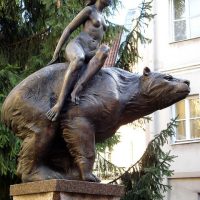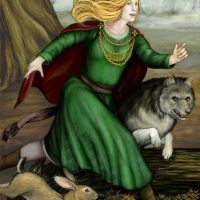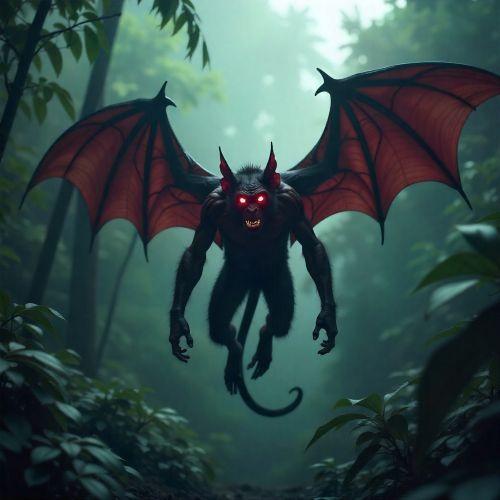Medeina : The Forest Goddess
Listen
At a glance
| Description | |
|---|---|
| Origin | Baltic Mythology |
| Classification | Gods |
| Family Members | Žvorūnė (Husband) |
| Region | Lithuania |
| Associated With | Nature, Forests |
Medeina
Introduction
Medeina, also known as Medeinė, is one of the most revered figures in Baltic mythology, celebrated particularly in Lithuanian folklore as the goddess of forests, wildlife, and hunting. Her name stems from the Lithuanian word medis meaning “tree,” directly linking her identity to the natural world. As a divine embodiment of the forest’s spirit, Medeina represents both its beauty and its wild, untamable essence. She is often compared to Artemis of Greek mythology or Diana of Roman legend due to her role as a virgin huntress and protector of animals.
Her worship dates back to pre-Christian Lithuania, especially during the 13th and 14th centuries, when sacred groves were key centers of spiritual life. Medeina’s significance extended beyond ecology—she symbolized independence, fertility, and the delicate balance between humans and the wilderness. As one of the chief deities in the Lithuanian pantheon, she was deeply connected to the people’s respect for forests, which they viewed as both sacred and sentient spaces.
Physical Traits
Medeina is often described as a young and strikingly beautiful maiden, embodying both the grace and danger of the wilderness. She is usually portrayed as nude or dressed in leaves, bark, or animal skins, blending seamlessly into the forest that she governs. Her flowing hair—often depicted as green or golden—represents the vitality of trees, while her piercing eyes mirror the depth of the woods.
In some tales, she takes on the form of a she-wolf (vilkmergė), symbolizing her dominion over the untamed and her role as a fierce guardian of wildlife. When in this form, she is said to lead a pack of wolves, protecting the forests from intruders and punishing those who harm animals unnecessarily. Earlier Baltic traditions even depict her as bear-like, reflecting her strength and the sacred connection between bears and the Baltic forest deities.
Medeina’s beauty, independence, and shapeshifting nature make her a symbol of both seduction and sovereignty, illustrating the duality of nature as nurturing yet unyielding.
Family
Unlike the structured pantheons of Greek or Norse mythologies, Baltic mythology is more fluid, and Medeina’s family connections are largely undefined or symbolic. Some accounts pair her with Giraitis, a lesser-known “grove god,” who may have been regarded as her twin brother or divine counterpart, representing the unity of masculine and feminine forces within nature.
Medeina is sometimes linked with Žvorūnė (or Žvorūna), another forest deity whose name derives from žvėris, meaning “beast.” While some traditions separate the two, others merge them into a single goddess who embodies both vegetation and animal guardianship. This blending reflects the Baltic approach to myth, where deities often overlap in domain and evolve through oral storytelling.
Unlike other goddesses associated with fertility or motherhood, Medeina remains unmarried and childless, representing an archetype of freedom and autonomy. Her independence from familial or marital ties underscores her identity as a protector of the wild—untamed, self-reliant, and sovereign.
Other names
Medeina’s worship spanned various regions and dialects, giving rise to multiple names and titles that highlight her diverse aspects.
She is most commonly called Medeinė, a linguistic variation of her name derived from medis (“tree”). In some folk traditions, she is identified as Žvorūnė or Žvorūna, a name emphasizing her association with wild beasts and hunting. The Latvian equivalent, Meža māte or “Forest Mother,” further illustrates her maternal link to the natural world and her protective nature over all living creatures.
These different names demonstrate her adaptability across Baltic tribes, reflecting local environmental and cultural influences while maintaining her core identity as the goddess of the forest. In modern interpretations, she is often referred to as Medeina-Žvorūnė, a fusion that captures her dual essence as both huntress and protector.
Powers and Abilities
Medeina wields immense power over forests, animals, and the balance of nature. Her influence governs the harmony between human life and the wilderness. Rather than assisting hunters, she protects the forest’s inhabitants, ensuring that nature remains undisturbed. She is known to bewitch or mislead hunters, causing them to lose their way or miss their prey, serving as a divine warning against greed and disrespect toward nature.
Her sacred animal is the hare, symbolizing agility, fertility, and divine guidance. According to legend, if a hunter encountered a white hare in the woods, it was believed to be Medeina herself in disguise, testing their virtue or luring them away from forbidden grounds. In certain medieval chronicles, such as the Hypatian Codex, Lithuanian rulers including King Mindaugas were said to fear her retribution and avoided hunting in sacred groves dedicated to her.
Medeina is also credited with shape-shifting into various animals, including wolves and bears, to defend her domain. She could summon forest creatures to aid her or to drive away those who violated the sanctity of the woods. During the winter solstice, rituals dedicated to her often featured participants dressed as animals, particularly bears and wolves, invoking her blessing for fertility, protection, and renewal.
In earlier eras, Medeina was also viewed as a war goddess, particularly in tribal warfare where forests served as both battlefield and refuge. As Lithuania transitioned into a unified state and later adopted Christianity, this martial aspect of her identity diminished, but her symbolic power as a guardian of nature and strength persisted.
Modern Day Influence
Despite the decline of her formal worship following Lithuania’s Christianization in the 14th century, Medeina’s spirit endures in modern Lithuanian culture, art, and environmental consciousness. She remains a national symbol of ecological balance and female independence, celebrated as both a mythic figure and a cultural archetype.
Contemporary Baltic neo-pagan movements, such as Romuva, have revived her worship, incorporating her into nature-centered rituals and festivals that honor the cycles of the seasons. She is often invoked as a patron of forest preservation and wildlife protection, resonating strongly in a world increasingly concerned with environmental issues.
Medeina’s image has also found a place in modern art and sculpture, most notably in a bronze statue by Lithuanian artist Marius Grušas, which depicts her seated atop a bear—a powerful symbol of her command over the natural realm. Her name continues to appear in literature, poetry, and neo-folk music, where she represents the enduring spirit of Lithuania’s ancient forests and the harmonious relationship between humanity and nature.
Interestingly, the Lithuanian Armed Forces named a unit the “Medeina Battalion”, underscoring her association with protection, strength, and resilience. This modern military homage reflects how her mythology transcends time, merging spiritual guardianship with national pride. In today’s Lithuania, Medeina stands not only as a relic of pagan mythology but as a living symbol of ecological awareness and feminine strength—a timeless reminder that the sacredness of nature continues to define both cultural identity and spiritual heritage.
Related Images
Source
Academia.edu. (2025). Medeina/Medeinė as a relic of Neolithic beliefs. Retrieved from https://www.academia.edu/74239387/Medeina_Medein%C4%97_as_a_relic_of_Neolithic_beliefs
Ancilla, M. (2021, April 19). Medeina—the Goddess of the Forest. Retrieved from maryancilla.com
Godchecker.com. (2023). Medeina—Lithuanian Goddess of Nature. Retrieved from https://www.godchecker.com/lithuanian-mythology/MEDEINA/
Grušas, M. (1988). Medeinė statue. Vilnius: PaganPlaces. Retrieved from https://paganplaces.com/places/medeine-statue/
Greimas, A. J. (1993). Lithuanian Mythological Symbols and Meanings. Vilnius University Press.
North Sea Poet. (2017, May 3). Mythology: Medeina. Retrieved from northseapoet.blogspot.com
Vaitkevičius, V. (2003). Lithuanian Sacred Sites and Deities. Kaunas: Lithuanian Folklore Institute.
Wikipedia. (2024, November 9). Medeina. Retrieved from https://en.wikipedia.org/wiki/Medeina
Frequently Asked Questions
What is lorem Ipsum?
I am text block. Click edit button to change this text. Lorem ipsum dolor sit amet, consectetur adipiscing elit. Ut elit tellus, luctus nec ullamcorper mattis, pulvinar dapibus leo.
What is lorem Ipsum?
I am text block. Click edit button to change this text. Lorem ipsum dolor sit amet, consectetur adipiscing elit. Ut elit tellus, luctus nec ullamcorper mattis, pulvinar dapibus leo.
What is lorem Ipsum?
I am text block. Click edit button to change this text. Lorem ipsum dolor sit amet, consectetur adipiscing elit. Ut elit tellus, luctus nec ullamcorper mattis, pulvinar dapibus leo.
What is lorem Ipsum?
I am text block. Click edit button to change this text. Lorem ipsum dolor sit amet, consectetur adipiscing elit. Ut elit tellus, luctus nec ullamcorper mattis, pulvinar dapibus leo.
What is lorem Ipsum?
I am text block. Click edit button to change this text. Lorem ipsum dolor sit amet, consectetur adipiscing elit. Ut elit tellus, luctus nec ullamcorper mattis, pulvinar dapibus leo.











